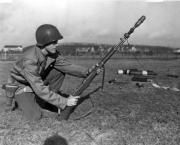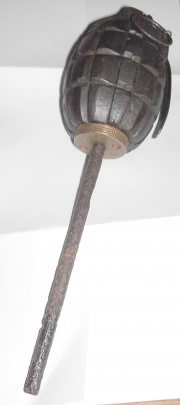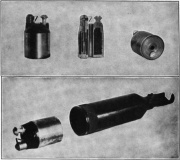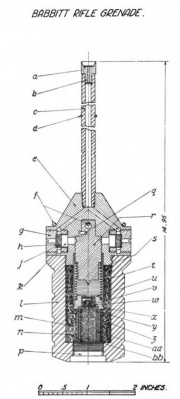Rifle grenade

A rifle grenade is a form of grenade that utilizes a rifle as a launch mechanism to increase the effective range of the grenade. The idea was first widely put into service during World War I and continues to this day. Many armies have replaced rifle grenades with dedicated grenade launchers.
Contents |
[edit] Advantages and disadvantages
The modern rifle grenade remains arguably a more effective weapon than the grenade launcher because:
- Rifle grenade warheads are larger (and thus possess greater power) than typical grenade launcher rounds.
- A rifle grenade can be fired from any field service rifle, thus making virtually any soldier into a "grenadier" when necessary, whereas grenade launcher rounds can only be fired from grenade launchers. The grenade launcher also adds the burden of the launcher to the service-member's load and in the case of under-barrel grenade launchers, to his primary weapon as well.
Offsetting these strengths are low velocity with an attendant arcing trajectory, and very high levels of recoil. These drawbacks combine to make rifle grenades extremely inaccurate weapons. Furthermore, the rifleman must "switch modes" and take a few moments to prepare to fire a rifle grenade; if a close-range target suddenly presents itself during this time, the soldier cannot immediately engage with his rifle. With the alternative under-barrel launcher, both weapon systems can be carried at the ready and this problem is mostly eliminated. Lack of accuracy is the main reason why most major armies have opted to replace rifle grenades with dedicated grenade launchers.
[edit] Operation
Historical rifle grenades used two different launching mechanisms:
- A stick that fit down the interior of the rifle barrel;
- A cup or special adapter that fitted on the end of the rifle muzzle.
For both these methods, a blank cartridge was required; in the former case, it propelled both the stick and the grenade. It was found that repeated use of a rifle for launching grenades by this method caused damage to the barrel, which is what led to the cup/adapter technique. The need to load a blank cartridge at the same time as the rifle grenade proved difficult in combat. Attempting to use a live round with either a stick or cup grenade launcher would have disastrous results.
The problem with having to load special ammunition has been addressed with the modern concepts of the "bullet trap" and "bullet through" rifle grenades. The former "traps" the live ball or tracer round within the grenade, and uses its energy for propulsion. "Bullet through" grenades, as for example the French Viven Bessieres (VB)used in World War I, have a hole through the middle that permits the passage of a standard bullet, and use the expanding gas to propel the grenade. Both of these methods remove the need for a special blank round to be loaded to launch.
Rifle grenades can be of any type as the more conventional hand grenades. However, two types predominate — fragmentation grenades, for use against personnel; and shaped charges for armoured vehicles. Rifle grenades may be time-fused, so that they detonate at a fixed time after firing, or impact-fused, so they detonate upon impact. Generally, antipersonnel grenades would be time-fused, and anti-armour grenades would be impact-fused.
Often, special sights that attach onto the rifle to provide aiming for the grenade's particular ballistics are employed. Since rifle grenades usually travel at low velocities with very high trajectories, their range is measured in tens of yards (meters). The maximum range of most rifle grenades was about 200 yards (180 m). Rifle grenades are often fired at angles greater than 45 degrees, allowing them to drop down at steep angles to enter trenches, or to hit targets behind cover; the steep angle also increased the time of flight, to give the fuse more time to burn, so it would detonate as soon as possible after reaching the target. Firing at lower angles was useful for placing grenades through windows or other vertical openings.
[edit] History
The grenade is an ancient weapon, and its revival and adaptation into the rifle grenade began around 1904. The first experiments are credited to a Japanese Colonel Amazawa, who experimented with rifle fired grenades during the Battle of Port Arthur in the Russo-Japanese War, and the idea was further used by the Spanish, though the French were the first to put it to widespread use during the trench warfare of World War I.[1]
The French grenade, named the V-B grenade after its inventors, Vivien and Bessières, was fired from the standard service rifle with the use of a special adapter and a standard cartridge, providing an effective range of around 175 to 200 yards, while the effective radius of the bursting grenade was 75 yards. The grenade had a hollow through the middle, allowing the bullet to pass through, while the muzzle blast was captured by the launching device and used to propel the grenade. The bullet, after passing through the body of the grenade, struck a small plate that ignited primer. This then lit the fuse in the grenade, providing an eight second delay before detonation. It could be fired from the shoulder, but due to the heavy recoil and poor balance of the rifle fitted with the grenade, it was more common to fire it with the butt of the rifle resting on the ground, and either held at an appropriate angle, or resting on a tripod. The rifle grenade was useful in offense, particularly in attacking sandbag fortified machine gun nests, as well as in defense. Eight men armed with rifle grenades could fire 150 shots in a minute, providing a heavy barrage to break up an attacker's lines.[2][3][4][5]
Upon entering the war, the United States attempted to adopt the V-B grenade, but this was not very successful. The difference between the French and American service cartridges (8 mm vs. 7.62 mm) meant that the grenade had to be re-designed with a smaller hole, but even this was not sufficient to ensure reliable functioning, due to differences in bullet design. The American bullet would often break apart in the grenade, and this led to the V-B derived grenade design being scrapped in May of 1918.[3]
The next United States attempt at a rifle grenade took a different track. The Babbitt grenade, developed by Colonel E. B. Babbitt of the U. S. Ordnance Department, used a long stem projecting from the rear of the grenade, which was slipped into the barrel of the Springfield 1903 rifle, and propelled with a special blank cartridge. The stem was calibrated with a number of grooves and a split ring, which allowed the user to set the grenade to slide a certain distance into the muzzle of the rifle. With the stem was inserted only part way, the chamber pressure upon firing was reduced, propelling the grenade a shorter distance. When fired at a 45 degree angle, ranges from 50 to 300 yards were possible; with the rifle angled at 80 degrees, ranges as short at 15 yards were possible. In addition to providing the force to propel the grenade, the gases from firing were directed through a hollow in the stem, and provided force to arm the grenade. Once armed, the grenade had a heavy plunger that would detonate the grenade upon impact.[6][7]
During WWII, the major change in rifle grenades had to do with the method of launching. Rather than using a bulky, cup-type launcher, like the French V-B grenade, "spigot" type launchers were developed by the German and American armies. The spigot attached the muzzle of the rifle, and the corresponding hollow-based, finned grenade fitted over the spigot. The resulting assembly closely resembles a spigot mortar. These types still used special, grenade launching blank cartridges for firing. Later designs used bullet trapping grenades, eliminating the need for blank cartridges, and modern assault rifle designs integrated the spigot launchers into the rifle's barrel and flash suppressor, eliminating the need for a special attachment.[8]
Rifle grenades were common during World War II, but by the late 1970s they were largely replaced by designated grenade launchers. These grenade launchers generally took form of independent firearms (such as the M79 grenade launcher), or as an attachment to an assault rifle (the most common example being the M203 attached to M16/M4-family of rifles).
Today, there is a return to the concept of the rifle grenade, such as the M16's SIMON breach grenade and the IMI Tavor's "Rephaim" advance grenade. Modern combination doctrine designates a certain percentage of grenadiers, or soldiers equipped with a grenade launcher or combination rifle/grenade launcher. The criticism of this doctrine is that if the grenadiers in a group are disabled or separated from the group, then the group has completely lost the grenade launcher as a heavy fire support. With rifle grenades, each soldier would be equipped with a small number of grenades, so every individual soldier could utilize some form of heavy firepower.
[edit] Less lethal use

The advent of less lethal grenades for riot control has led to the creation of gun launched versions of these grenades, though they are typically launched by riot shotguns, not rifles. These systems use a cup-type launcher attached to the muzzle of the gun to launch various less lethal grenade types.[9]
[edit] Legal issues
In almost all countries, grenades are illegal for civilian ownership, though dummies (inert grenades with no fuse, detonator or explosives) are usually legal.
In the United States, rifle grenades are covered under the National Firearms Act as "destructive devices". A civilian could legally own a grenade in theory, but the requirement of a police chief's signature in certain places often makes owning such items legally nearly impossible.
Rifle grenade launchers are not subject to the National Firearms Act, although stand-alone grenade launchers may be, and rifle grenade launchers may be regulated by local law.
[edit] See also
[edit] References
- ↑ Cornélis De Witt Willcox, Edwin Roy Stuart. The International Military Digest Annual, 236.
- ↑ Walter Hines Page, Arthur Wilson Page (1918). The World's Work: A History of Our Time. Doubleday, Page & Co., 501.
- ↑ 3.0 3.1 United States War Dept. America's Munitions 1917-1918, 208 - 209.
- ↑ Anne Cipriano Venzon, Anne Venzon, Paul L. Miles (1999). The United States in the First World War: An Encyclopedia. Taylor & Francis, 172.
- ↑ Robert B. Asprey. At Belleau Wood, 19.
- ↑ United States Army. Ordnance Dept, Ordnance (1917). Description and Instructions for the Use of Rifle and Hand Grenades.
- ↑ William Harvey Tschappat (1917). Text-book of Ordnance and Gunnery. John Wiley & Sons, Inc., 511.
- ↑ Franklin D. Margiotta, Gordon R. Sullivan (1997). Brassey's Encyclopedia of Land Forces and Warfare. Brassey's, 40. ISBN 157488087X.
- ↑ INSTRUCTOR OUTLINE Civil Disturbance Lesson Plan MILITARY POLICE INSTRUCTION COMPANY, UNITED STATES MARINE CORPS, 14 AUG 07 (Word document)



